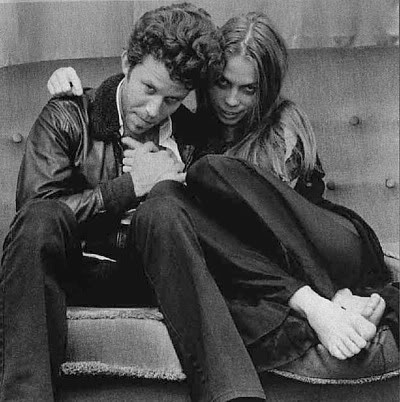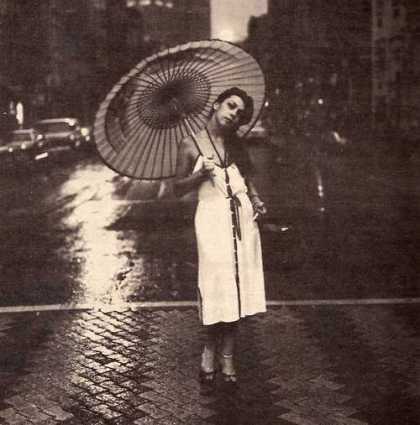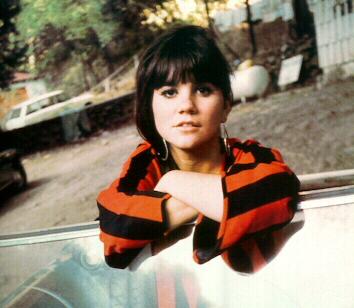 When Rickie Lee Jones met Tom Waits, they seemed to be a match made in heaven. They shared a love of beat poetry and jazz, and their songs were mired in the same cracked, ragged romanticism that colored their worldview. He was a struggling singer-songwriter with half a dozen albums under his belt, and she was an unknown performer who’d been invited to sing some of her songs at the famous Troubadour club in Los Angeles. Watching Rickie Lee perform that night in 1977, Tom was impressed by her good looks and talent, and the two became an item soon after.
When Rickie Lee Jones met Tom Waits, they seemed to be a match made in heaven. They shared a love of beat poetry and jazz, and their songs were mired in the same cracked, ragged romanticism that colored their worldview. He was a struggling singer-songwriter with half a dozen albums under his belt, and she was an unknown performer who’d been invited to sing some of her songs at the famous Troubadour club in Los Angeles. Watching Rickie Lee perform that night in 1977, Tom was impressed by her good looks and talent, and the two became an item soon after.
While they shared many common interests, they came from very different backgrounds. Tom was a middle-class kid who was slumming it by living in the notorious Tropicana Motel in Hollywood. In contrast, Rickie Lee was a former teenage runaway who waited tables to make ends meet, sleeping under the Hollywood sign when she couldn’t pay rent.
Along with their good friend Chuck E. Weiss, also a singer-songwriter, Rickie Lee and Tom were inseparable. When Tom released his 1978 album Blue Valentine, Rickie Lee and Chuck E. were included in the photos for the record’s cover. The album included a song called “Red Shoes by the Drugstore”, an evocative Yuletide story inspired by Rickie Lee.
 Shortly after the release of Blue Valentine, Rickie Lee began to attract the attention of record companies. Her song “Easy Money”, along with several others on a demo she’d been shopping around, earned her a record deal. The girl who was formerly known as “the mysterious blond” on Tom Waits’ album cover was about to become a star in her own right. When Rickie Lee’s self-titled debut was released in 1979, it was an immediate sensation. Filled with breezy songs like “Young Blood” and “Danny’s All-Star Joint”, mingled with gorgeous ballads such as “On Saturday Afternoons in 1963”, the album painted a vivid portrait of street life. Released to radio in a year that was dominated by disco and new wave, the jazzy single “Chuck E’s In Love” sounded like nothing else on the airwaves. The album, and it’s debut single, both reached the top five on Billboard charts. A performance on SNL and a Grammy for Best New Artist cemented her reputation as the fastest-rising star in rock. On tour, Rickie Lee was dynamic. Chuck E. remembered, “She could move people so quickly. At shows, I used to watch people in the audience just crying their eyes out when she sang.” The press also fell for her personal style, with her trademark berets, fingerless gloves, and vintage shoes. But while she made the cover of Rolling Stone, troubles were brewing. Her life of instability and poverty had left her unprepared for success, and she began to cope first with alcohol, then with harder drugs. Chuck E. recalled that her record label didn’t seem to care what Rickie Lee was doing to herself, as long as she kept touring and writing songs. Her relationship with Tom suffered. He was unable to deal with her success (her debut had outperformed all of his albums, many times over), as well as her drug problem. Sometime in late 1979, they broke up. Perhaps scared straight by watching Rickie Lee’s struggles, Tom moved to New York and sobered up.
Shortly after the release of Blue Valentine, Rickie Lee began to attract the attention of record companies. Her song “Easy Money”, along with several others on a demo she’d been shopping around, earned her a record deal. The girl who was formerly known as “the mysterious blond” on Tom Waits’ album cover was about to become a star in her own right. When Rickie Lee’s self-titled debut was released in 1979, it was an immediate sensation. Filled with breezy songs like “Young Blood” and “Danny’s All-Star Joint”, mingled with gorgeous ballads such as “On Saturday Afternoons in 1963”, the album painted a vivid portrait of street life. Released to radio in a year that was dominated by disco and new wave, the jazzy single “Chuck E’s In Love” sounded like nothing else on the airwaves. The album, and it’s debut single, both reached the top five on Billboard charts. A performance on SNL and a Grammy for Best New Artist cemented her reputation as the fastest-rising star in rock. On tour, Rickie Lee was dynamic. Chuck E. remembered, “She could move people so quickly. At shows, I used to watch people in the audience just crying their eyes out when she sang.” The press also fell for her personal style, with her trademark berets, fingerless gloves, and vintage shoes. But while she made the cover of Rolling Stone, troubles were brewing. Her life of instability and poverty had left her unprepared for success, and she began to cope first with alcohol, then with harder drugs. Chuck E. recalled that her record label didn’t seem to care what Rickie Lee was doing to herself, as long as she kept touring and writing songs. Her relationship with Tom suffered. He was unable to deal with her success (her debut had outperformed all of his albums, many times over), as well as her drug problem. Sometime in late 1979, they broke up. Perhaps scared straight by watching Rickie Lee’s struggles, Tom moved to New York and sobered up.
 Exhausted and heartbroken, Rickie Lee wrote songs and kicked her drug habit. In 1981, she released her masterwork. Pirates was a top five album; the world was glad to have Rickie Lee back again. Many of the songs on the album were inspired by her breakup with Tom. In a style that had evolved from the bebop of her first album to a sound that evoked early Bruce Springsteen, Rickie Lee laid herself bare. The epic “We Belong Together” hurls words at an imaginary Tom Waits:
Exhausted and heartbroken, Rickie Lee wrote songs and kicked her drug habit. In 1981, she released her masterwork. Pirates was a top five album; the world was glad to have Rickie Lee back again. Many of the songs on the album were inspired by her breakup with Tom. In a style that had evolved from the bebop of her first album to a sound that evoked early Bruce Springsteen, Rickie Lee laid herself bare. The epic “We Belong Together” hurls words at an imaginary Tom Waits:
I say this was no game of chicken
You were aiming at your best friend
That you wear like a switchblade on a chain around your neck
I think you picked this up in Mexico from your dad
Now it’s daddy on the booze
And Brando on the ice
Now it’s Dean in the doorway
With one more way he can’t play this scene twice
So you drug her down every drag of this forbidden fit of love
And you told her to stand tall when you kissed her
But that’s not where you were thinking…
How could a Natalie Wood not get sucked into a scene so custom tucked?
But now look who shows up
In the same place
In this case
I think it’s better
To face it
We belong together
“Lucky Guy” laments the ease with which Tom moved on, and “Livin’ It Up” regales the listener with stories of Rickie Lee, Tom, and Chuck E. But it’s the title track that contains the most explicit references to the relationship, with lines like “I’m holding on to your rainbow sleeves”; a sly nod to “Rainbow Sleeves”, the song written by Tom Waits that he gave Rickie Lee to perform. She went on to comfort him about his lack of commercial success: “You keep the shirt that I bought ya, and I know you’ll get the chance to make it/And nothing’s gonna stop you, you just reach right out and take it.” In the end, the album documents not only the end of a relationship, but the strength of a woman who had the courage to be so staggeringly honest; a woman who knew that her talent was worthy of the success she reached out to take.



